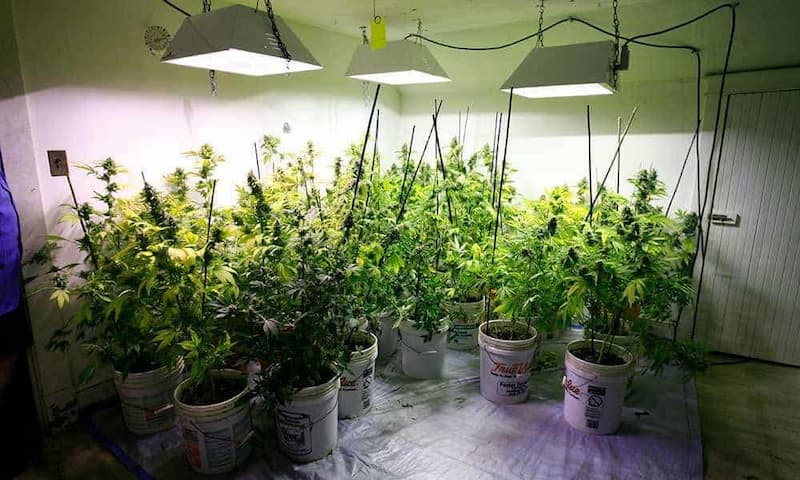If you’ve ever thought about growing indoors, you’ve probably faced a tricky question; should I buy a grow tent or build a grow room? If you decide to go with the latter, we’ll go over the basics you’ll need to turn an ordinary room into an indoor plant without breaking the bank. In general, turning a full house into a grow room costs more than simply buying a grow tent; read on to learn how to build a grow room for your plants.
Things You’re Going To Need To Build A Grow Room
Aside from the physical space to build your grow room, you will need.
- A tape measure to get the exact size specifications,
- Wood or something to build a grow tent or cabinet,
- Reflective material or paint,
- Ventilation equipment,
- Grow lights,
- Tools, such as screwdrivers, a power drill, and scissors.
How to Build a Grow Room

1. Finding A Space
Planning your grow room is not just a place where you will grow your plants. You need to consider several factors
Consider building your grow room close to a water source. Like a sink so you don’t carry buckets after buckets of water to water your plants.
An outlet and power strip are needed nearby to install lights, fans, and possibly a heater or humidifier.
2. Light Proofing
A growth chamber completely protected from light is absolutely essential. In the first case, light leaks can be annoying because the grow lights are very bright. If your grow room is a bedroom cupboard, or set up in a spare corner of any occupied room, light leaks can keep you awake at night. At worst, it will advertise that you are growing weeds throughout the community.
Second, light leakage into the growth chamber can adversely affect plant performance. Once plants have been flipped to a 12-12 day-night cycle to induce flowering, light leakage can confuse plants, leading to reduced yields, hermaphroditism, and even crop failure due to light stress. All growers keep a close eye on male plants, but a few well-hidden bananas from a female plant can ruin the entire crop and make it into seed production.
3. Flooring
Your flooring material needs to be easy to clean and disinfect, and it must be strong and resistant to moisture.
Bare concrete is a poor choice because of its porosity and how it absorbs moisture and other chemicals. These are then filtered back into the air, creating a harsh environment for your plants.
Covering concrete floors with epoxy, paint, or other liquid coatings can help solve the problem. Or you can lay mylar or vinyl flooring, which is the same as epoxy does.
4. Climate Control
Cannabis thrives when the climate is controlled in terms of humidity and temperature, some parameters ideal for vegetation and others for flowering.
Humidity can be easily controlled with a dehumidifier; these are also available as double-acting units, increasing or decreasing humidity as needed. During vegetation growth, moist and warm conditions increase growth rates, while lower humidity and temperatures increase shoot development.
Temperature can be controlled using a small portable reverse cycle AC unit. Many humidity conditioners and heaters have built-in thermostats and hygrometers so they can be turned on and off as the environment demands. Just put them in place and you can rest assured that your weeds are thriving at every stage; automating the entire process makes growing much easier.
5. Ventilation
Without proper airflow, carbon dioxide can run out and humidity fluctuates too much, both of which can harm plants.
Later, you’ll create a way for air to flow in your grow room. Use an inline duct fan to push stale air out of the room to create a constant airflow for the growth of your cannabis plants.
Unless your room is well ventilated, you’ll have to install an exhaust fan and maybe an intake fan.
6. Safety and Fire Prevention
While most growers harvest without any surprises, many horror stories document how bad things can get when an accident occurs.
While many cannabis growers prefer to operate as little as possible, others prefer to use as many useful gadgets as possible. However, even a small amount of electronics in a grow space is at risk of fire.
When it comes to electronics, water remains one of the biggest risks in a grow room. Water will interrupt the current flow, possibly resulting in a fire or electric shock. Keep electronics as high above the ground as possible to prevent water leaks.
Put a fan in your grow room to regulate the temperature. While this means more electronics floating in the air, the fans create a flow of cool air that helps keep the device from overheating.
Using a ground fault circuit interrupter (GFCI) will help stop leakage if it occurs. The kit can detect when electricity is flowing in a pool or body where it shouldn’t and break the circuit.
7. Cleaning The Space
Before you start building your grow room, be sure to remove everything that could be causing contamination.
Remove carpets or rugs as they can leave behind bacteria, parasites, and other pathogens that can destroy crop yields.
So make sure to remove everything else to create a blank slate, then sanitize and clean the room before continuing.
Final Thoughts
You don’t need to be a professional DIYer to build a grow room or an experienced gardener to develop a healthy and productive cannabis crop.
If your grow space doesn’t allow for custom builds, you can always check out my grow tent review as it will make your job easier.
But at the end of the day, all you need is creativity and a good sense of planning to create room for your cannabis needs to grow.

















